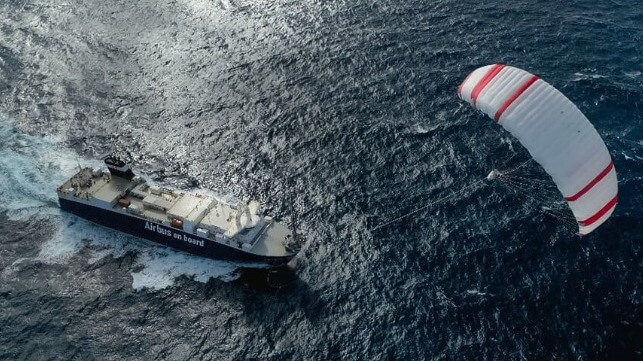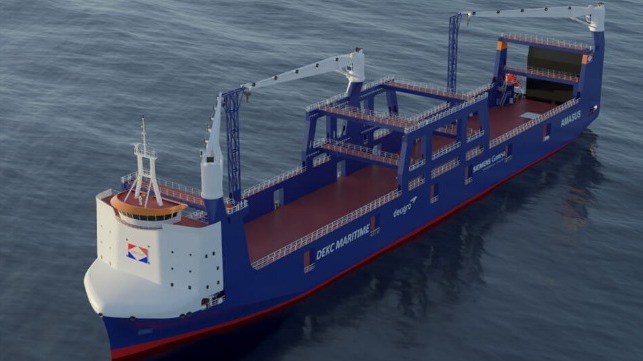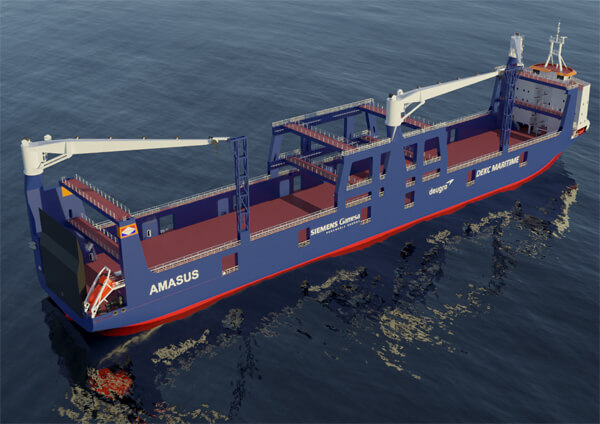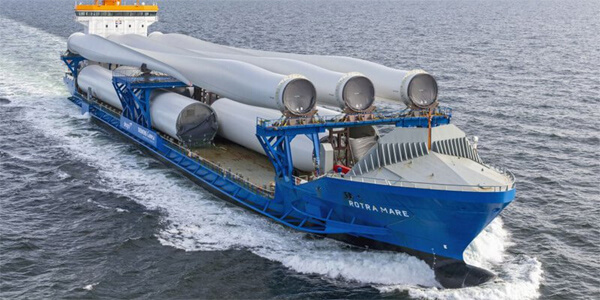Seawing Kite Achieves Traction in Ongoing Sea Trials Aboard Ro-Ro

PUBLISHED MAY 16, 2023 4:52 PM BY THE MARITIME EXECUTIVE
The French company Airseas, which was created with technologies from the aviation industry’s Airbus, reports it has achieved a key milestone in the testing of its wind propulsion system known as the Seawing. As part of the ongoing sea trials aboard an in-service Ro-Ro, they successfully delivered the first traction from the kite system to the vessel.
The engineers explained that the system for the first time was positioned after earlier flight tests. After lowering it to the correct angle for propulsion, they achieved traction sufficient to provide wind-assisted propulsion to the Ville de Bordeaux, a 5,200 dwt cargo Ro-Ro which is operated by Louis Dreyfus Armateurs and chartered by Airbus. The ship is sailing transatlantic between France and the U.S. Gulf Coast transporting components for Airbus.
Airseas reports the tests show that the system is working as designed. Previously, the company had said their research showed that the Seawing would have a pulling power of up to 100 tons meaning it can contribute to propulsion for a ship of over 200,000 tons and over 1,000 feet in length. They project fuel savings on average of 20 percent by deploying the kite sail.
“We are immensely proud of the technical achievements that we have accomplished so far in our sea trials, and there is more to come,” said Vincent Bernatets, CEO and Co-Founder of Airseas.
The initial installation began in late 2021 after six years of development since having been spun off from Airbus. Testing began in late 2022 with the team having both a 250 m2 version of the wing and a 500 m2 version while the commercial concept calls for a 1000 m2 parafoil, to fly at altitudes of nearly 1,000 feet capturing the stable higher altitude winds to assist vessel propulsion.
During the first tests, they validated the systems including the launch, take-off, ascent, descent, and landing. The system is fully automated. They reported that the Seawing was flying more than 650 feet above sea level. Having demonstrated the ability to generate traction, the tests are now working on the automation system and the flights.
The company is also working with Japanese shipping company K-Line, which has announced plans to also begin testing the system this year. K-Line installed the system on one of its bulkers and also reported plans to outfit it on a new vessel next year. K-Line has an initial contract for five vessels and based on the outcomes of the tests has a 20-year agreement that calls for installing the Seawing on 51 vessels.
Airseas reports that it is working to scale up operations including plans for a commercial factory that they expect to open in 2026. Their goal is to have the system broadly commercially available by 2031.
New Ro-Ros Built in China to Transport Larger Wind Farm Components

PUBLISHED MAY 16, 2023 3:38 PM BY THE MARITIME EXECUTIVE
The challenges of handling the transportation of wind turbines and their components are increasing due to the demand as well as the larger sizes of the new equipment. Wind turbine manufacturer Siemens Gamesa Renewable Energy and freight forwarder deugro are expanding their relationship with shipping company Amasus Offshore for a new generation of vessels to meet these future demands.
The companies report since 2016 they have been using Ro-Ro heavy load carriers to transport the wind turbine materials. They report the approach reduces the risk, loading time, and costs through the use of the Ro-Ros outfitted with a unique gantry system.
Siemens Gamesa and deugro entered into a long-term charter agreement for two new vessels that will expand these capabilities that will be operated by Amasus Offshore. According to the companies, the ships, which will be built at Jiangsu Zhenjiang Shipyard in China and are scheduled for delivery in the spring and summer of 2025, are customized for transporting offshore wind turbine components.
The ships, which will be named Rotra Futura and Rotra Horizon, will be larger than the existing ships Rotra Mare and Rotra Vente, and expand the concepts pioneered with the earlier class to provide capabilities for larger components for wind farms. Each of the new ships will be approximately 550 feet long and have a beam of 85 feet.

Deckhouse was moved forward on the new class to eliminate line-of-sight limitations and easier cargo loading (deugro)
“In Rotra Futura and Rotra Horizon, we will have the right assets in place to meet future challenges and to perform essential operations,” said Thomas Mortensen, Head of Offshore Project Transportation at Siemens Gamesa. “This new combined fleet will ensure that we have a strong foundation from which we can execute and deliver in line with our operational expectations.”
To accommodate the increased size and weight of the next generation of offshore wind turbine components, the new ships will also be Ro-Ros outfitted with a gantry system. Unlike the older class, the deckhouse and accommodations will be placed forward to optimize cargo intake and operational flexibility without line-of-sight limitations. The vessels will have a stern Ro-Ro ramp, the gantry system, and three Liebherr cranes, allowing stowage of blades in three tiers, while providing flexibility in cargo composition and method of loading.
Consideration was also included in the design to enhance the environmental performance of the ships making them IMO Tier 3 compliant. Energy consumption will be reduced with an aerodynamically and hydro-optimized hull shape, a low-resistance special hull coating, and a Wärtsilä diesel engine with a 15 percent lower consumption and carbon footprint compared to today’s standards. There will also be an efficient power train with a hybrid propulsion system, an exhaust gas cleaning system, and waste heat recovery.

Rotra Mare is one of the two vessels currently employed and which were recently modified for larger wind components (Amasus Offshore)
The current agreement from the three companies is employing the Rotra Mare (9,200 dwt) built in 2009 which is now 500 feet in length after having been expanded in 2022. Also employed is the Rota Vente (8,800 dwt) built in 2016 which is 464 feet in length. A year ago, both vessels underwent modifications to prepare them to also handle the larger components for wind farms. The cover over the cargo area was removed and sponsons around the hull as well as modifications to the bow and Ro-Ro ramped were made to the Rotra Vente. Both vessels returned to service transporting equipment for Siemens Gamesa and deugro under the trilateral agreement with Amasus Offshore.
No comments:
Post a Comment